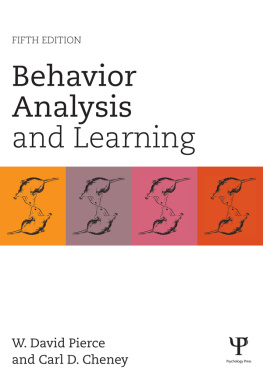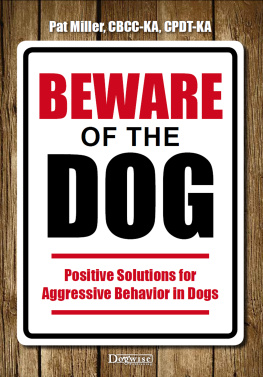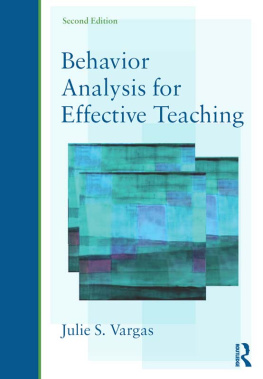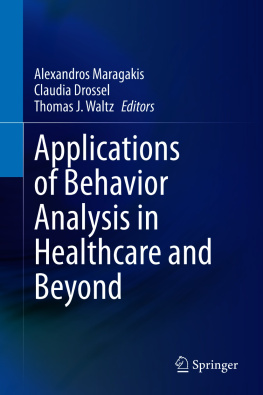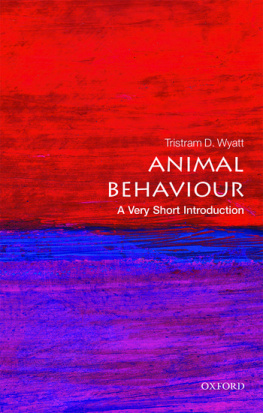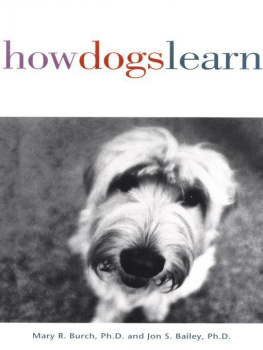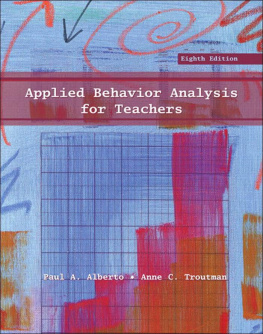
Behavior Analysis and Learning
Fifth Edition
W. David Pierce and Carl D. Cheney

W. Frank Epling, Ph.D. was coauthor of the first two editions of Behavior Analysis and Learning. He was a great personal friend of ours, an excellent teacher, and a productive colleague. We hope that this fifth edition is as good as Frank would accept, and we dedicate it to his memory.
The goal of this textbook is to present and describe the philosophy, methods, findings, principles, and applications of the natural science of behavior analysis. This fifth edition presents the history, current status, and projections for the future of humans investigating what accounts for their behavior.
We have received a great deal of welcome positive feedback from readers of earlier editions, which we greatly appreciate. This fifth edition retains much of the major organization, information, and unique features of the previous editions, yet, as with any revision, we have made several alterations in topics, presentation, and resources. We responded to user and reviewer comments and to the availability of much new information from the literature. Reviewers reported that, although this is a basic experimental analysis text, they enjoyed the applied human and nonhuman examples, and so we have expanded and continued this feature. A single college textbook cannot do justice to both basic and applied behavior analysis, and our focus has remained primarily basic so as to provide the fundamentals, where they came from, and how they may apply in diverse situations. It is our belief that, given a solid understanding of the behavior principles presented in this text, the reader will be equipped to analyze, design research or treatment, carry out an effective behavioral assessment, and be successful with the behavior management of most species.
Many readers indicated an appreciation of the use of Francis Mechners notation system as a clear depiction of the experimental contingencies and the independent variables that control behavior. Dr. Mechner remains active and thoughtful in producing creative and challenging research in behavior analysis (see on thinking), and we have used his system since graduate school.
Users and reviewers also encouraged us to include more biobehavioral findings, which we were pleased to do. For example, the reports of mirror neurons and their possible involvement in imitation and empathetic behavior have been expanded. We have also noted important research relating activity in the brain area called the nucleus accumbens to choice behavior, and the involvement of the amygdala in conditioned reinforcement. An elaboration of the evolution of the human vocal apparatus and verbal behavior contributes, we feel, to the synthesis of biology and behavior. Although we remain dedicated to behavior analysis as a discipline of its own, we appreciate the movement toward a synthesis of a science of behavior with neuroscience. Ultimately the brain is responsible for nearly all behavior (headless cockroach data being one exception), and eventually our knowledge of brain mechanisms together with understanding of the environmental features that contribute to behavioral contingencies will provide a means of prediction and control beyond what we may have thought possible.
The pedagogical features in the fifth edition have proven successful and include the Focus On inserts, Advanced Sections , and On The Applied Side presentations. The placement of Advanced Sections at the end of chapters allows instructors to address basic material without the intrusion of more complicated issues. We now include sections on New Directions in behavior and neuroscience in most chapters to highlight the links between behavior analysis and direct observation of neural systems and processes. As in the past, we continue to provide Chapter Summaries , which we expect will improve students mastery of the material.
In this edition we have updated nearly all areas, topics, and coverage with new findings (there are more than 300 new citations), and we have incorporated several different study features. For readers/users all study questions, PowerPoint presentations, video vignettes illustrating specific points, and other material considered helpful, are available on a dedicated website at www.psypress.com/cw/Pierce. Using this system, the authors (and instructor) can add, delete, or alter material as considered appropriate. Many additional websites are indicated which can guide the reader to current material of interest. Websites are a major resource, and we encourage the instructor to incorporate web assignments whenever appropriate. A thorough reading of the text is sufficient to acquire the basic principles; however, most students nowadays are fluent with the web, and actually expect to access information via this medium.
The fifth edition continues to be primarily about the way the world works with respect to operant behavior and operant conditioning. We continue, however, to provide an extensive, updated, and detailed chapter on respondent (classical) conditioning, although the Advanced Section is abbreviated and less demanding than in previous editions. As in the past, we address respondent conditioning with regard to the habitual use of drugs and the concepts of tolerance, craving, and withdrawal.
The sections on behavior analysis applied in education settings, autism, and health (e.g., breast self- examination, obesity, and anorexia) have been extensively expanded, as has the emphasis on principles of selection and the biological context of conditioning. New findings in the area of epigenetics have contributed to our highlighting of the contribution of the early and developing environment to behavior. Behavior analysts, of course, recognize the essential nature of biological contributions and constraints while simultaneously emphasizing what can be done with arbitrary selective procedures (contingency management) to alter socially important (in fact all) behavior.
The organization of the book has not changed, because we consider it now to be a systematic and reasonable progression of behavior science, as a book format requires. We recommend assigning and treating the material in the order in which it is presented; of course, individual adjustments and adaptations are possible for personal considerations best left to the instructor. on reinforcement and extinction is followed by schedules of reinforcement, which is the major independent variable of behavior analysis. The section on reinforcement schedules promotes the fact that all operant behavior varies in rate and form with the existing contingencies, both in the laboratory and in the everyday world of organisms. Next, we introduce the topic of the use of aversive procedures, and the by- products of aversive control are detailed and emphasized. Many contingencies in the world are based on aversive consequences, so although we do not recommend their use, we believe that the reader needs be aware of what behavior science has to offer with regard to this issue. This particular order of the chapters allows us to more fully address the contingencies of positive and negative punishment, and negative reinforcement (escape and avoidance). By this point in the book all of the basic contingencies have been introduced and shown to be operative in both research and observations of everyday life.
After presenting the basic principles, the text moves to the interrelationship of operant and respondent contingencies and the biological context of behaviorshowing that operant and respondent processes often (if not always) work together, sometimes in opposition, in complex interacting relations. At this point, we consider issues of antecedent stimulus control and the regulation of higher- order behavioral processes such as conditional discrimination, remembering, and concept formation. Choice and preference analysis based on concurrent schedules of reinforcement are the next logical step; here we present a thorough treatment of the matching law for concurrent and single operant situations. Under choice, we now address research on optimal foraging and extensively describe the research, concepts, and applications of behavioral economics, attempting to clarify the breadth and application of these areas of investigation. As the natural science of behavior continues to maturethis is about the 50th anniversary of Behaviorism at Fifty, published by Skinner in 1963 (
Next page
